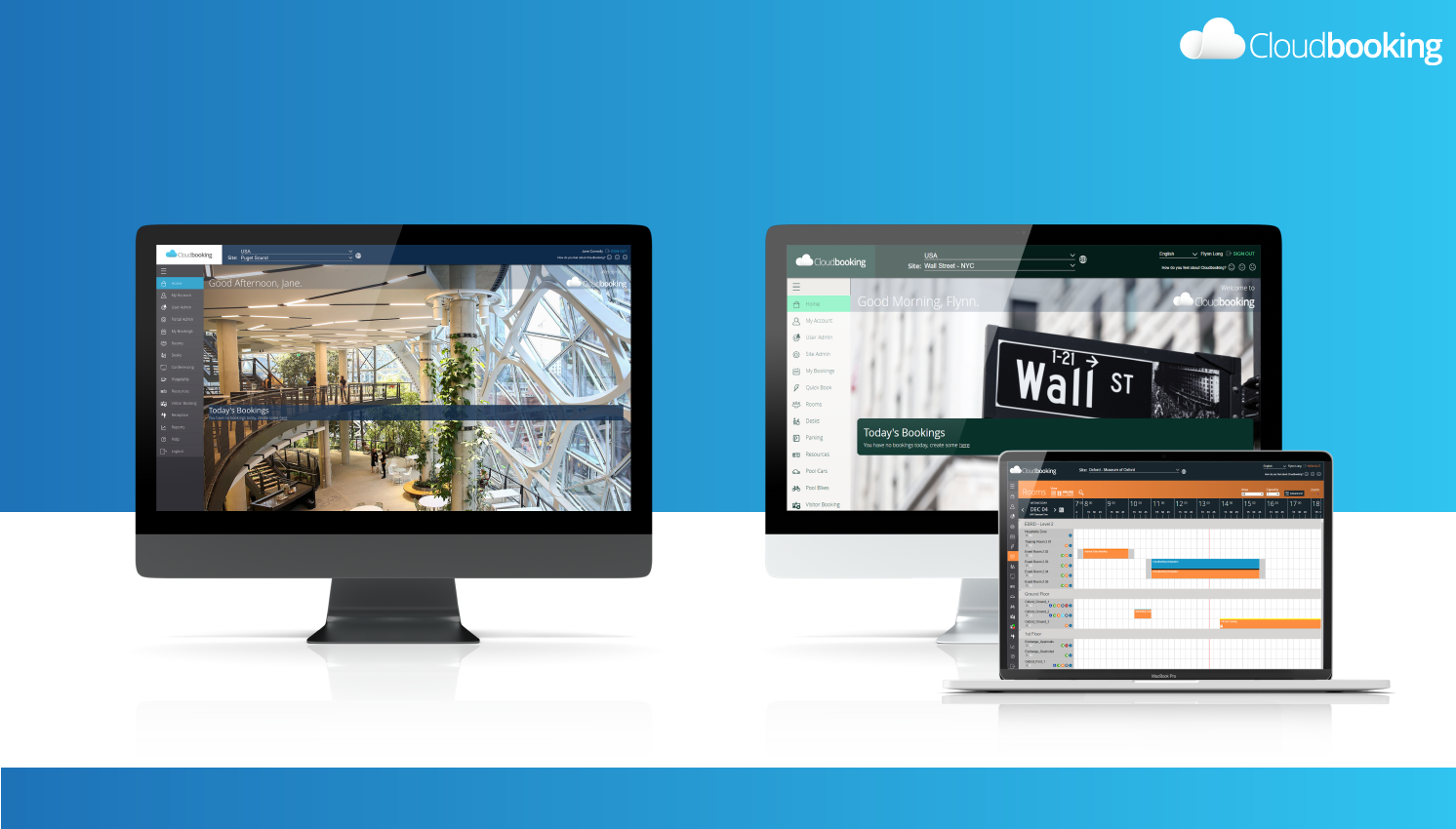
What Is Hot Desking? Explaining the Not-So-New Work Fad
The world of work is always undergoing change, adaptation, and modernization, and that includes the workplace itself. The global pandemic in 2020 left businesses in an unprecedented position. Employees who had become used to daily commutes and a fixed nine-to-five schedule had to create their own home office and deal with the distractions of working from home.
However, fast forward two years to the announcement of “freedom day” and the Living with COVID-19 plans set out by the UK government, and it has gradually become clear that greater workplace flexibility is essential for success. This is where hot-desking comes into play. Although this organizational workspace system is not new, it does appear to be a viable solution moving forward. Here at Cloudbooking, we take an in-depth look at “what is hot desking?”
Hot desking is essentially a flexible seating arrangement and a type of hybrid work that allows the employees of an organization to take whatever desk they find available to them rather than having a specific space assigned to them. The term is said to have come from the expression “hot racking,” referring to the practice of sailors with different shifts sharing the same bunks.
This flexibility is now an attractive option for organizations looking to welcome workers back into a designated office space. A report from the JLL property group found that 37% of global organizations have plans to increase their use of co-working or flexible space post-pandemic. As we edge towards the second half of 2022, hot desks are a viable solution for companies looking to adopt a hybrid working model.
Hybrid work looks set to go from strength to strength thanks to the autonomy and flexibility it offers and as 83% of workers prefer a hybrid-work model, it appears that hot desking could be the latest workplace trend making a comeback.
What is hot desking?
If you are wondering, “what is hot desking?” or aren’t totally sure what it entails, let’s break it down and start with the basics. As we previously mentioned, hot desking is an organizational workspace system in which desks in a workspace are used on an ad-hoc basis. This means that workers use whatever hot desk is available, rather than having one assigned space or permanent desk.
The aim of hot desking is to maximize space efficiency and reduce redundant office space. Hot desking is a strategy that helps improve flexibility and encourages collaboration, whether in an office environment or a co-working space.
Hot desking vs desk hotelling/desk booking
This is where it can get a little more confusing; there are two forms of hybrid work and desk-sharing practices that, to the untrained eye, can appear to be quite similar. These are hot desking and desk hotelling or desk booking. Both of these forms of hybrid work offer employees greater flexibility and support their productivity while also utilizing office space more efficiently than traditional office practices. But what is the difference between them? Let’s take a look.
Hot desking
With hot desking, workers use whatever hot desk is available to them, rather than having a permanently assigned desk. The company can use a range of factors to determine how hot desks are allocated — assignments can be rotating, “first come, first served,” or shift-based, depending on your teams. These desk assignments can be changed multiple times a day.
Desk hotelling
When it comes to desk hoteling, on the other hand, employees can reserve or book a desk or workspace prior to, or on arrival to, the office space. The reservation of desks and workspaces requires companies to adopt workspace management systems like the one we offer at Cloudbooking.
Cloudbooking workplace management software offers several convenient features that help ensure the seamless adoption of desk hoteling, such as enabling employees to book their desks, meeting rooms, and parking spaces, all in advance.
Companies can also benefit from the innovative software as it also allows employers to organize and optimize their working environment with live data on productivity.
Both hot desking and desk hoteling give workers control and variety within their work environment. They are also beneficial forms of hybrid work that encourage activity-based working (ABW). ABW is a style of work that encourages employees to choose from various workplace settings, according to the nature of what they are doing. The main difference between the two types of hybrid work is the more formalized approach that desk hoteling takes, thanks to the implementation of dedicated booking technology.
What are the advantages of hot desking?
There is a wide range of flexible working strategies. Although all have benefits, hot desking is a very appealing option for today’s employers. Hot desking is not a particularly new workplace strategy, and yet it was adopted by a growing number of companies before/during the COVID-19 outbreak. In fact, the demand for hot desking increased by 45% during 2020, according to Deloitte.
Now the return to the office is well underway, a flexible approach to employee attendance looks set to continue. Many workers are expressing their desire to continue working from home or remotely, which makes it likely that hot desking will continue to be a popular workplace strategy and a solution that works for both employees and employers, thanks to its range of benefits. What are the advantages of hot desking? Let’s take a look.
Onboarding process
One of the many challenges companies have faced when working from home is the onboarding of new employees. This process is a complex and vitally important part of the employee journey. However, any employees hired during the national lockdowns won’t have too much difficulty adjusting to the hot desking way of working. They will already be fairly experienced using the various systems and services that are also likely needed for hot desking. The only real introduction required is meeting co-workers and finding a comfy seat.
Socialize with co-workers
We are creatures of habit — many of us enjoy having our own desk or seat, or we like the comfort of being surrounded by the same co-workers day in and day out. However, this does make it difficult to start conversations with colleagues from other departments and build new inter-organizational relationships.
Hot desks promote a healthy mixing of staff, enabling employees to get to know the roles of other teams and help give employees a better overview of what task each department carries out. This socializing also helps build an improved workplace culture that will help make it a better place to work. Definitely one of the main advantages of hot desking!
Minimize mess
People often tend to treat their workspace as their own. This means that many desks and offices are full of clutter, knick-knacks, and wires. Hot desking removes this problem by forcing employees to be more organized and work in a more minimalist environment. Although some people may like personalizing their workspace, hot desking does lead to an easier job for the cleaning staff and a more presentable appearance.
Increased autonomy
Hot desking isn’t just a big change to your physical workspace; it’s also a massive change to your company culture. People are no longer stuck working at their desks; instead, workers have a say on what their day looks like. This can have a transformative effect on both the social and the home lives of employees.
Save money
The traditional office environment is usually designed so each employee has a specific space to work in. The trouble is that much of this office space is completely wasted when employees are on annual leave, off sick, or away on a business trip. It is highly unlikely that every employee will require a desk each day, especially now that many have chosen to partly work from home, which means that traditional offices rarely use their space and equipment efficiently. Hot desking, on the other hand, allows businesses to not only cut down on their equipment costs but also potentially downsize their real estate and reduce overheads.
Empowering employees
When employees are happy and positive, productivity is high. Even though everyone is different, for most employees, having the flexibility to move around and sit at any desk they choose is empowering.
Choosing for yourself means that you can also find the right environment to carry out each task efficiently. If you need peace and quiet, you can find a quiet corner of the office, whereas if you want conversation and input, you can move to a busier, more collaborative space.
Updating infrastructure
To offer an entire workforce the flexibility of hot desking, most businesses will need to update their infrastructure. What do we mean? Well, employees will need to be able to access everything they need to do their job remotely. This means that internal business systems will need to be moved to the cloud, and services like HR, payroll, and printing will have to become available to all employees, no matter where they are in the building.
Challenges of hot desking
From a simple employer’s point of view, hot desking seems like a no-brainer: reduce office space and reduce overheads. However, when you look at some of the real-life hot desking case studies, it’s clear that it might not always be the perfect solution.
Last week, a LinkedIn poll was taken asking: “Do you enjoy hot-desking at work?” It turned out that a resounding 75% of respondents clicked on “no.” There are many reasons why hot desking hasn’t been able to win over the majority of employees, but the inability to personalize desk space and the lack of privacy seem to be among the most common.
In hot-desking environments, workers are always moving from desk to workstation. This means personal items like knick-knacks, family photos, etc., can’t be used to decorate a space. Experts found that allowing employees to personalize their desks can positively impact their morale and energy. This means that hot desking can run the risk of negatively affecting employee morale and even leave them feeling less valued.
Although hot desking is meant to encourage collaboration and improve productivity, many teams can become spread out and separated due to desk-occupancy levels. This can damage communication and have a detrimental impact on productivity. Hot desking can also leave employees feeling unsettled and unhappy, which is never good for business — as you probably already know, unhappy employees can cost organizations billions of dollars each year.
Finally, on the topic of communication, some employers found that although hot desking made the office a more open and welcoming place to work, it could actually have a negative effect on productivity. In fact, just 46% of workers feel they are more productive when working in a hot-desking environment compared to working at their own desk. This negative impact is due to the constant distractions and conversations that hot desks can sometimes encourage.
Is hot desking the answer?
As we look towards the future of work, it is clear that every time the increased focus on flexibility and freedom is brought up, so is hot desking. Flexible ways of working are in vogue, and it is up to you to find the right workplace strategy for your business. While adopting an organizational workspace system like hot desking has a plethora of benefits, it won’t suit all employees.
If you are considering hot desking for your business, it is also worth looking at desk hoteling. Office hoteling could be a more viable option for organizations looking to move with the times and adopt flexible-workplace strategies. Many of the complaints aimed at hot desking include lack of privacy, disorganization, and the feeling of being undervalued by the company.
Desk hoteling uses innovative workplace management solutions technology to enable employers to plan and organize their office attendance while also helping employees find and book suitable workspaces and meeting rooms that meet their needs. Furthermore, Cloudbooking’s COVID-19 solutions and visitor management technology can even help look after your employee’s health and keep them safe, yet another way companies can prove that looking after their employees is of primary importance.
There is a wide range of options when it comes to hybrid workplace models. By fully understanding your industry and your workplace goals, you can find the right solutions for your workspace and your business.
Find out how Cloudbooking can help you successfully adopt your own hybrid work model with our very own workplace management software. Contact us now for a no-obligation product demo.


